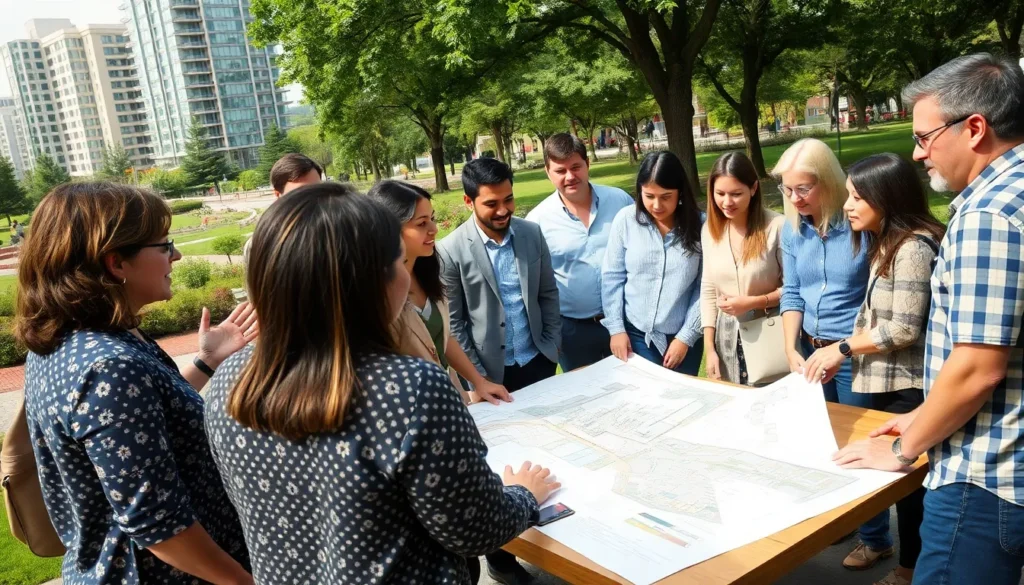Cities are evolving faster than a toddler in a candy store. As populations swell and urban landscapes transform, urban shift planning has become the unsung hero of modern city life. It’s not just about putting up shiny new buildings or adding a few more bike lanes; it’s about crafting a vibrant, sustainable future that works for everyone.
Imagine a city where traffic jams are a myth and parks are as common as coffee shops. Urban shift planning is the blueprint to make that dream a reality. By rethinking how communities function, it tackles everything from housing shortages to environmental concerns, all while keeping a sense of humor about the chaos that often accompanies city living. Dive into the world of urban shift planning, where creativity meets practicality, and discover how cities can thrive in this ever-changing landscape.
Table of Contents
ToggleOverview of Urban Shift Planning
Urban shift planning encompasses strategic approaches to manage rapid city transformations. This planning addresses housing shortages, environmental challenges, and community building effectively. Stakeholders focus on integrating sustainable practices into the urban fabric, aiming for vibrant, livable environments.
Cities face increasing pressure from population growth and shifts in demographics. Planners prioritize mixed-use developments, which promote walkability and reduce reliance on cars. Additionally, urban shift planning encourages the use of green spaces and public transit options, enhancing overall quality of life.
Collaboration among government entities, private developers, and community groups plays a crucial role. Engaging local populations in decision-making leads to a stronger sense of ownership and accountability. Each participant can contribute unique perspectives, creating comprehensive solutions tailored to specific urban settings.
Sustainability remains a core principle. Planners incorporate renewable energy sources, efficient waste management systems, and climate-resilient infrastructure. These elements work together to promote a healthier environment for current and future generations.
Successful urban shift planning also looks at economic revitalization. By attracting businesses and fostering innovation, cities can create job opportunities for residents. Furthermore, balanced attention to social equity ensures all community members benefit from urban improvements.
Prioritizing these factors in urban shift planning results in cities that adapt and thrive. The combination of creativity and practicality is essential for developing spaces that remain dynamic and resilient over time. This holistic approach allows urban areas to evolve while addressing the fundamental needs of residents.
Key Concepts in Urban Shift Planning

Urban shift planning involves strategic frameworks that direct urban growth and transformation. This approach enhances sustainability and adaptability, helping cities meet the challenges posed by rapid population changes.
Definition and Importance
Urban shift planning defines processes that manage and guide urban transformation. It plays a crucial role in creating sustainable communities while addressing housing, transportation, and environmental issues. Planners emphasize the need for innovative practices to enhance livability. Resilient cities emerge from comprehensive planning that considers the future landscape. Effectively executed, urban shift planning leads to improved quality of life for citizens.
Goals of Urban Shift Planning
Urban shift planning aims to create vibrant, equitable, and sustainable urban spaces. Enhancing walkability remains a priority, as mixed-use developments encourage residents to engage with their surroundings. Promoting green infrastructure contributes to climate resilience, while preserving natural resources directly impacts the environment. Strengthening community ties fosters collective ownership and encourages participation in local initiatives. By attracting businesses, planners stimulate economic growth that generates job opportunities. Ultimately, successful urban shift planning seeks to balance environmental, social, and economic factors to ensure that all community members benefit from urban improvements.
Challenges and Opportunities
Urban shift planning presents both challenges and opportunities for cities adapting to rapid changes. Addressing these elements effectively requires strategic approaches that capitalize on existing trends while mitigating potential risks.
Urbanization Trends
Growing populations lead to increased urban density, impacting housing and transportation systems. Cities report that mixed-use developments emerge as a solution to accommodate rising demands, fostering walkability and reducing car dependence. According to the U.S. Census Bureau, urban areas saw a 10% population increase from 2010 to 2020. Adopting smart growth principles enables planners to manage this influx sustainably, emphasizing smart transportation systems. Diverse community needs drive innovative urban designs that create inclusive spaces, encouraging interaction among residents.
Environmental Considerations
Sustainable practices form the basis of effective urban shift planning. Utilizing renewable energy sources remains critical in combatting climate change impacts. Cities increasingly invest in green infrastructure, such as parks and permeable surfaces, to manage stormwater efficiently. The Environmental Protection Agency indicates that urban areas contribute approximately 75% of carbon emissions. By integrating climate-resilient designs, planners enhance the adaptability of the built environment. Collaboration with local organizations promotes awareness of environmental challenges. This involvement engages communities, encouraging grassroots efforts toward sustainability.
Case Studies of Successful Urban Shift Planning
Successful urban shift planning showcases innovative practices transforming cities into more sustainable environments. Various urban areas serve as prime examples of best practices and learning points.
Examples from Major Cities
Barcelona exemplifies effective urban shift planning through its superblocks initiative. This approach reduces traffic, enhances walkability, and creates vibrant public spaces for communities. Similarly, New York City’s open streets program expands pedestrian areas, promoting outdoor dining and recreation. On the other hand, Copenhagen focuses on cycling infrastructure, aiming for a 50% mode share for biking by 2025. These cities illustrate different strategies while prioritizing sustainability and community engagement.
Lessons Learned
Integrating community input has proved essential for successful urban shift planning. Stakeholders who participate in the planning process foster a sense of ownership over urban projects. Adopting mixed-use developments enhances livability, addressing housing shortages effectively. Additionally, focusing on green infrastructure mitigates climate impacts while creating appealing urban spaces. Investing in renewable energy resources strengthens resilience against future challenges. Cities must continually learn from these case studies to adapt and improve urban environments.
Best Practices for Implementing Urban Shift Planning
Implementing urban shift planning requires a comprehensive approach that incorporates several best practices. Prioritizing community engagement fosters a sense of ownership among residents. Utilizing open forums and surveys allows citizens to voice their opinions and concerns, ensuring their needs shape development projects.
Incorporating mixed-use developments significantly enhances walkability and accessibility. These projects combine residential, commercial, and recreational spaces, reducing reliance on automobiles. Integrating public transportation options into urban design encourages more sustainable commuting choices.
Planning efforts should emphasize environmental sustainability. Incorporating green infrastructure, such as parks and green roofs, positively impacts urban ecosystems and enhances residents’ quality of life. Utilizing renewable energy sources also contributes to a healthier and more sustainable city.
Leveraging data and technology facilitates improved decision-making and planning efficiency. Using geographic information systems (GIS) enables planners to analyze urban trends and population patterns effectively. This approach supports informed choices regarding land usage and resource allocation.
Collaborating with multiple stakeholders enhances the planning process. Engaging government entities, private developers, and community organizations creates a cohesive strategy that benefits everyone. This collaboration promotes shared accountability and fosters mutual respect.
Ensuring adaptability in urban planning helps cities respond to evolving needs. Creating flexible guidelines enables a timely response to changing demographics and environmental challenges. Regularly revisiting and updating plans based on feedback and new data strengthens resilience and long-term viability.
Establishing clear metrics for success is essential for tracking progress. Identifying specific goals helps measure the impact of urban shift planning over time. Regular assessments allow for timely adjustments and improvements, ensuring that plans meet community needs effectively.
Urban shift planning is essential for creating cities that thrive in an ever-changing world. By prioritizing sustainability and community engagement, planners can foster environments that enhance quality of life for all residents. The integration of innovative practices and mixed-use developments not only addresses pressing challenges but also promotes a sense of ownership among citizens.
As cities continue to evolve, the focus on collaboration among stakeholders will be key to developing cohesive strategies that meet diverse needs. Embracing technology and data-driven decision-making will further empower urban planners to adapt to future demands. Ultimately, successful urban shift planning will lead to vibrant and equitable urban spaces that benefit everyone.









